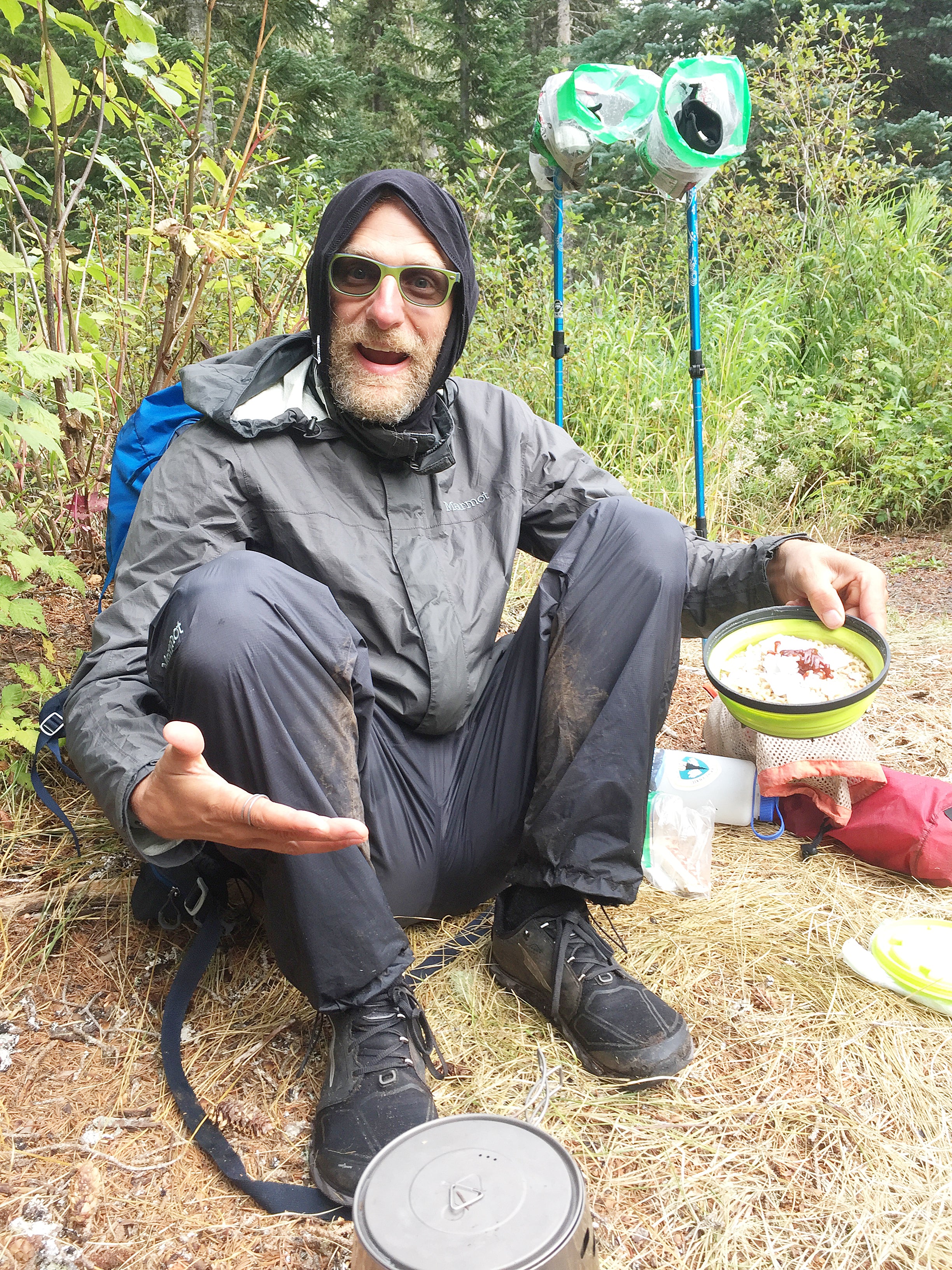

On April 16th, 1996 Peter Bergman and his friend Dylan Kuhn took their first steps on the Pacific Crest Trail—a notorious 2,653 mile route that winds up from the base of California right to the Canadian border.
For most, this arduous trek would be a serious task in itself, but for Peter—an art prankster who spent most of 1995 placing notices in the windshields of white convertible VW Golfs, inviting the owners out for dinner—it was the platform for performance art.
The plan was simple… sort of. They’d set out on their walk, and then around six weeks into the hike, on the day Peter was meant to be attending his graduation, he’d put on his suit—which he’d then wear for the rest of the trip, regardless of rips, tears or stench.
Things didn’t quite go to plan, and when a combination of pinched nerves, numb feet and harsh conditions put a stop to the trek with 900 miles still to go, a pact was made that the pair would return when they were twice as old to complete the walk. 23 years later, in 2019, they picked up where they left off.
In this interview I talked to Peter about performance art, thru-hiking, failure, ageing, rites-of-passage, youth, the random nature of life and cheap suits…
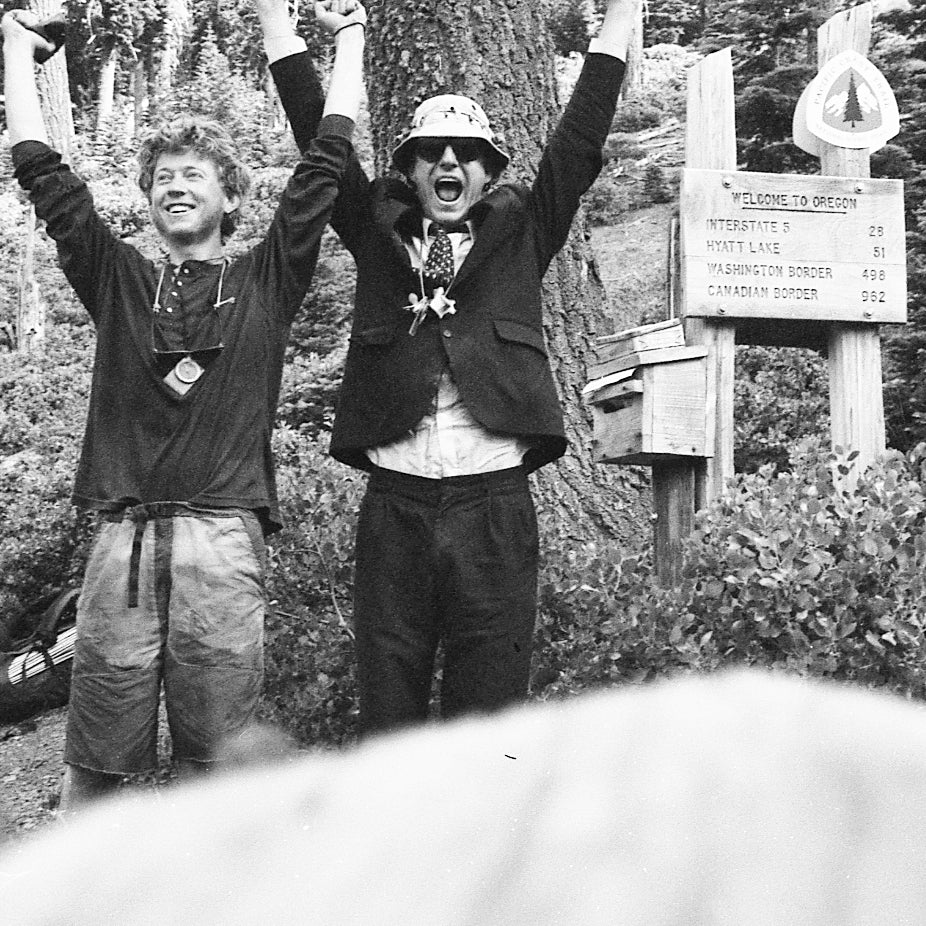
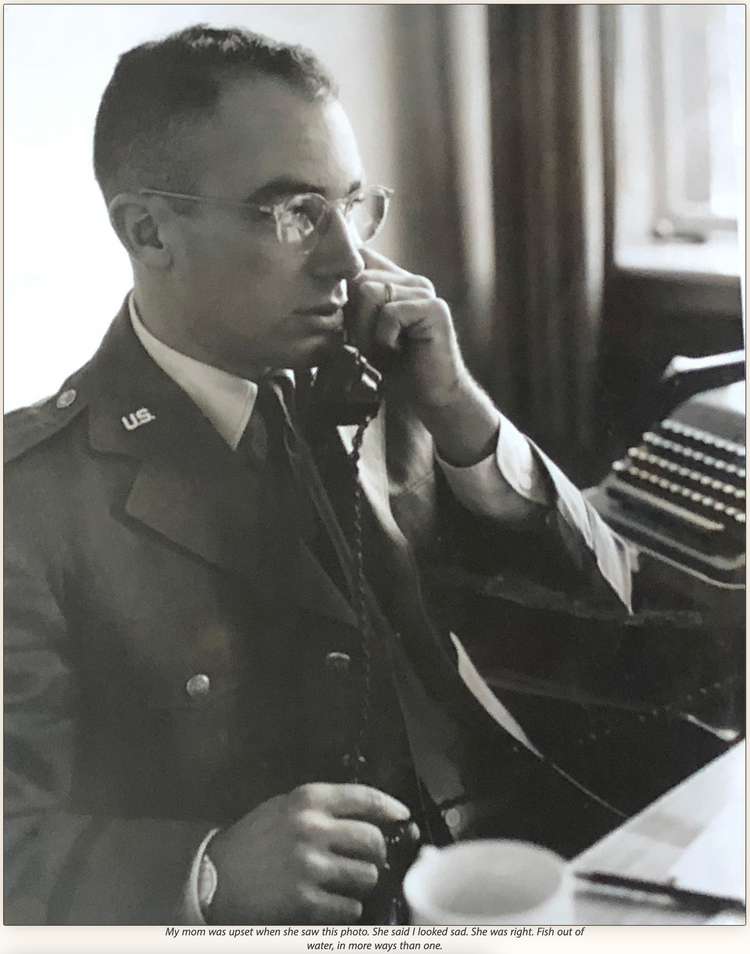
Sam: The main thing I wanted to talk to you about was your Pacific Crest Trail project—PaCT. How did that come about? Where did the idea come from?
Peter: There are several long trails in the United States—the Appalachian Trail, the Pacific Crest Trail and the Continental Divide Trail. My hiking partner Dylan and I were pretty outdoorsy people—we grew up in Wyoming where there wasn’t much to do but hike or ski or rock-climb or maybe skateboard in town. So the PCT was something I knew about and wanted to try.
Also at the time I was heavily enmeshed in an art practice that was really rooted around the fusion of art and everyday life—creating artwork that wasn’t object oriented—but instead about the lived experience. So I thought, “There’s gotta be something I can do on this trip”—an art project in parallel with the hiking project.
Part of that involved doing an animation—a flipbook animation—chronicling the whole journey, keeping some journals and then also—because I was really kind of an extremist in my mentality at this time—I had this cheap business suit my mom had bought me to wear for my sister’s wedding. I was skipping my college graduation ceremony to go on this trip, so I thought that maybe on the day I should have attended graduation, which would be about a month and a half into the trip, I’d then wear the suit all of the time.
It’d be interesting and out-of-context, being out of the wilderness in this cheap business suit. And I’d let it rot off my body. So that was the set-up. When we set off from the border, we were going to hike from the Mexican border to Tuolumne Meadows in Yosemite, where I’d get the suit, and then we’d continue on the remaining 2000 miles. But it didn’t really go to plan…
Sam: Just so I get this straight, the suit was sort of symbolic? You were casting off the shackles of the corporate world?
Peter: Yeah, it was a contrarian move. I wasn’t the kind of person who pictured myself living my adult life wearing a suit. I was only going to have one. When I bought it, the guy asked my mom and I, “What do you need this for?” I told him my sister was getting married, and he kind of sized me up—I was this punk skateboarder—and he said, “So basically you’re going to wear this to your sister’s wedding and some job interviews, you might wear it to your own wedding and then you’ll be buried in it. It’s the only suit you’ll ever own.”
And that kind of lodged in my mind. Wouldn’t it be great to put it through this extreme duress, and then still wear it to those occasions, even though the arm would be ripped off and it wasn’t washed?
There’s this German artist Joseph Bueys, and he wore the same clothes everyday—a sports jacket, a white shirt and a flat brimmed hat. And I thought that was kind of interesting. And there was an artist I took a class from, Barbara T. Smith, and she did this project in the 70s where she travelled up the west coast of California hitchhiking without any baggage—just wearing what I’d maybe describe as a mime suit. She wouldn’t talk to anyone—she had a vow of silence for the whole trip, travelling from Southern California to Washington by sticking her thumb out. So peripherally those things came together, and then regardless of circumstance, I wanted to create some kind of project out of it. The hiking in itself was a project, but it wasn’t an art project per se. It’s just a rite of passage—an exploration of the world… but what can you do during that? You can’t take much with you, so clothing is one option.
Sam: To some people, the walk would be enough. Was there a part of you at that point thinking, “I’m going to do something better than just walk a trail”? Almost a showing off thing? At that age there’s often a bit of anger.
Peter: Yeah totally. There was a hubris to the whole thing—as if walking 2650 miles is just a given—so let’s add something extra. Like you said, in your early 20s you have this energy—maybe anger or anti-social sentiment—to put people off somehow in the way you carry yourself. I was used to being the person who on a full bus no one would sit next to—because of my appearance or energy. So I was just kind of continuing that tradition of anti-social angsty youth…
Sam: I’m a bit younger than you so I can’t say too much from experience, but it seems like around that time there was a real ‘freak out the squares’ thing going on. Where did that come from?
Peter: I think there were a couple of factors. For those people who were in their early 20s then, their formative years would have been in the 1980s—with Reagan, Thatcher and the Cold War—a time of existential angst and extreme conformity. But coming out of that era were these cultural phenomena like punk and hip-hop which were anti-authority. And I was heavily into skateboarding, which at that time was an illegal activity—so there became this kind of self-referential cycle where people who were into skateboarding for the athletic pursuit became anti-social punks, and the people who were already anti-social punks recognised it as maybe as a sport that was welcoming to them.
And also there was more of an emphasis culturally on creating unique experiences and an increasing access to tools to document that kind of stuff. There were VHS cameras and affordable point-and-shoot film cameras, desktop publishing, people making zines, the internet being brand new—so people who were more tech-savvy were getting into hacker forums. There was all this stuff fuelling that kind of attitude.
Sam: Yeah—so you could document something like your trip. These things were cheap and attainable.
Peter: Yeah. I’d been making zines in college and learning about printing and the internet—which was in its infancy and kind of seen as this stupid fad.
Sam: What was ‘the art’ of the trip? Was it the product—the book you might make—or was it the trip?
Peter: At the time the way I would have conceived it was that it was performance art in the sense of what that meant post-1960s. It was art as opposed to theatre. Allan Kaprow, the person who coined the term ‘happenings’, where people would just get together, was the person who taught my introduction to visual arts at the university.
And I took a lot of classes with Eleanor Antin, who was a 20th century performance artist. They were really into this ‘art as life’ symbiosis where the performance is in the modification of your daily routine—it’s not theatrical or done for an audience. An example being Eleanor Antin in the 1980s proclaimed herself to be the King of Solana Beach. She had this regal attitude and this cape, and she’d walk around talking to people in this official, formal English. She ended up getting involved in mediation of disputes between developers and the traditional residents because people were like, “Well, let’s get the King to decide.”
Sam: They’d accepted the role?
Yeah, and that was kind of the influence. And then the book was the artefact. You did these things, and you documented them. So the first part of the trip was really from that mentality, and then the second part more recently was more from the ‘art as artefact’ attitude, where the trip is kind of generative—something to do to finish the story.
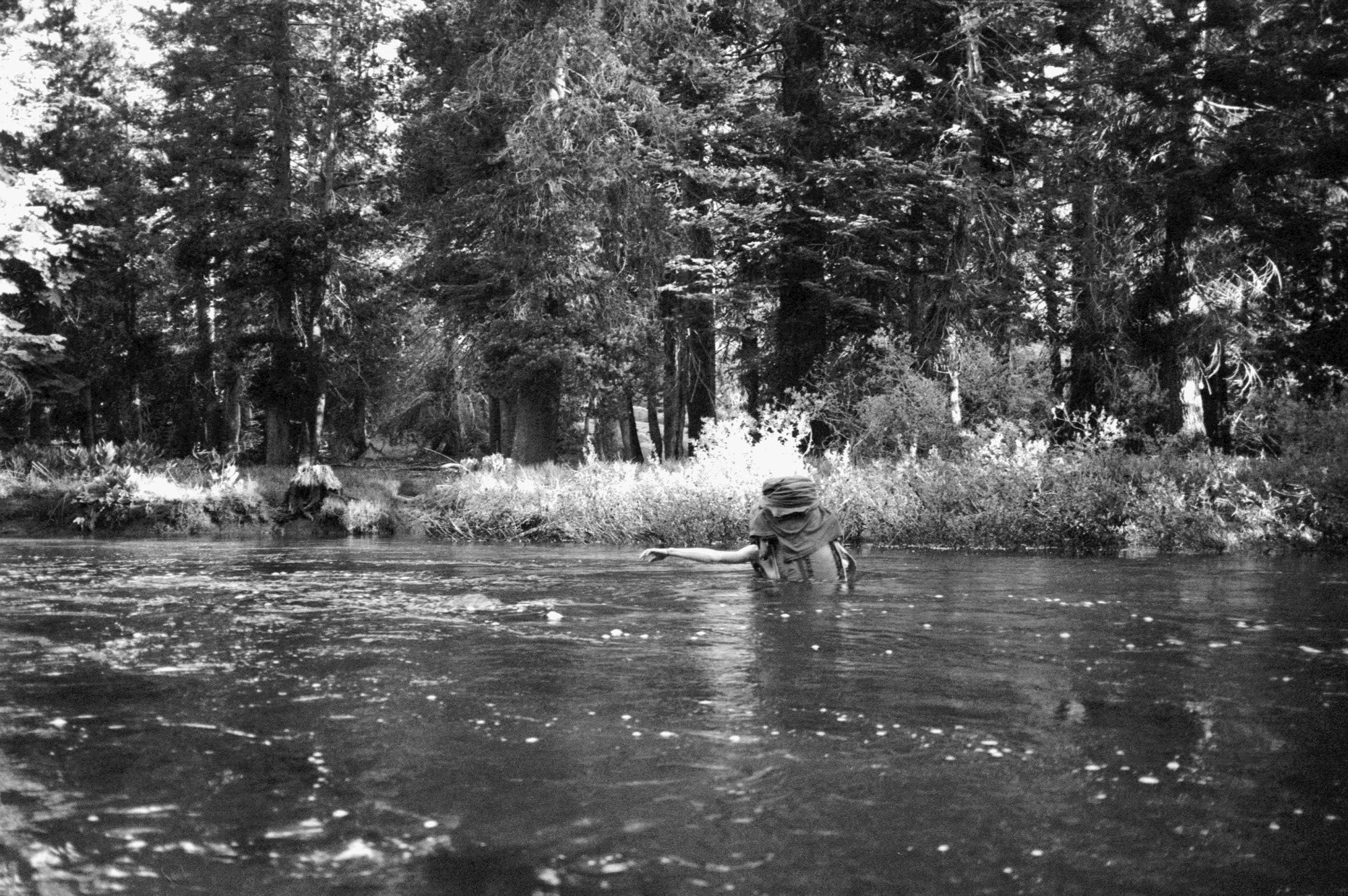

Sam: So that brings us to the walk itself. The first part, in 1996—what happened there?
Peter: We hit it pretty hard. We were going 20 to 25 miles a day from day one, carrying about 35 pounds, before adding food and water—that’s about triple what people carry today. We started in mid-April, and it was a heavy snow year that year so it took us a month to get to Southern Sierra Nevada—they’re big mountains—the tallest in continental US.
And so we get into snow conditions, doing about 100 miles on snow-pack, going over eleven passes that were as high as 13,000 feet in ten days. We were crossing rivers up to our arm-pits, but still maintaining that pace of 20 miles a day because we were a little bit on the clock because Dylan had to get back as he was going to re-attend college. The goal was to get into Oregon then hit it with 35 miles a day, but we were hurting. My feet were so messed up that it’d take about three or four miles in the morning until they stopped really painfully hurting, and they’d just numb out. And Dylan had a pinched nerve in his back. He was also out of money.
So when we were getting into Northern California we were just burned out. It’d been 90 days at 25 miles a day through some pretty tough conditions, and his back was really getting bad. He called it eventually—he couldn’t go any further. We weren’t going to finish in time anyway, and he was going to do permanent damage to his back, so we decided we’d do another 200 miles to Oregon and then stop there.
He said, “Let’s come back next summer and finish.” But I was so over it. He was more of an outdoors person than myself. But I thought, “How about we come back and finish when we’re twice as old.” We made an agreement—we wrote it out and signed it in a trail register, and then later that year I went on a roadtrip with a friend of mine, and I took the suit with me.
Sam: What had happened with the suit?
Peter: It had been lost in the mail, and it really only arrived about twelve days before we ended up finishing. I buried it in a time capsule in the Siskiyou Mountains in Oregon, right where we stopped. The idea was that I’d dig it up in 23 years and then finish the project.
Sam: How did you feel after having to call it quits on that first attempt? Was it frustrating that your project was out the window?
Peter: Yeah, it was a total failure in my mind. There’s that hubris of being young and thinking you can achieve anything—and even though what I was interested in doing was probably mis-directed socially—I was still fairly high-achieving.
Sam: You’re not becoming the CEO of some company, but it’s probably just as difficult.
Peter: Yeah. It was something that really made me think—what is the limit of your own endurance? Many, many people have gone out hiking—leaving in the morning and coming back in the evening—but just to repeat that day after day—your body and mind kind of breaks down to the point you can’t do it anymore.
And also, there are other people on the trail. In 1996 there weren’t many—but I think there were around 200, and maybe 50 of them finished, and a lot of them weren’t nearly as physically capable as we were. We were 23 year old athletic young men, but we were pushing ourselves that hard. And when you stack up your own abilities against others, there were two people on the trail that year—Scott Williamson and Kenny Gould—who were trying to be the first people to hike from Mexico to Canada and back to Mexico again in one stint.
Sam: What’s that called… a yo-yo?
Peter: Yeah, they were doing 35 mile days everyday. They made it to Canada and back down to the Sierras and then had to quit because it started to snow. And actually Scott Williamson tried that five more times over the course of the next decade before he did it.
So you’re in this head-space where you think you can achieve anything, and then you can’t even achieve the relatively modest thing—never mind what people like that were trying. And that made me re-assess what that meant. I feel like part of what I was doing at that time was trying to impose meaning onto things. I’m going to come up with this idea, and try out this activity and that’s going to mean something that I’ve pre-ordained, and then that kind of failure made me realise that if you’re trying to do projects about the lived experience, then that’s not what the lived experience is. The lived experience is random—and if you’re fortunate, it’s very long. So these things don’t need to be contained in a brief period of time.
Sam: Yeah, things aren’t black and white. 23 years later you completed the trip. What made you two stick to your pact? Was it because you didn’t want to let each other down? It’s rare that people plan that far ahead—and even rarer that they stick to it.
Peter: Yeah, I think having another person helps, for sure—it keeps you accountable. And partly it was that extremist attitude. As you mature you lose some of that angst, but you hang onto the experiential nature of things—wanting to have these really far out experiences. I think people do plan a long time in advance, it’s just about kind of pedestrian things.
Neither of us have kids, and I think there are several reasons for that, and one of those is this desire to do these activities where you’re living outdoors for months at a time. I went the path of pursuing those experiences through the lens of art, and Dylan went down the path of outdoor exploration. He spends a lot of time climbing and backpacking and back-country snowboarding. He and his wife lived in a truck-topper for two and a half years at a bunch of climbing spots.
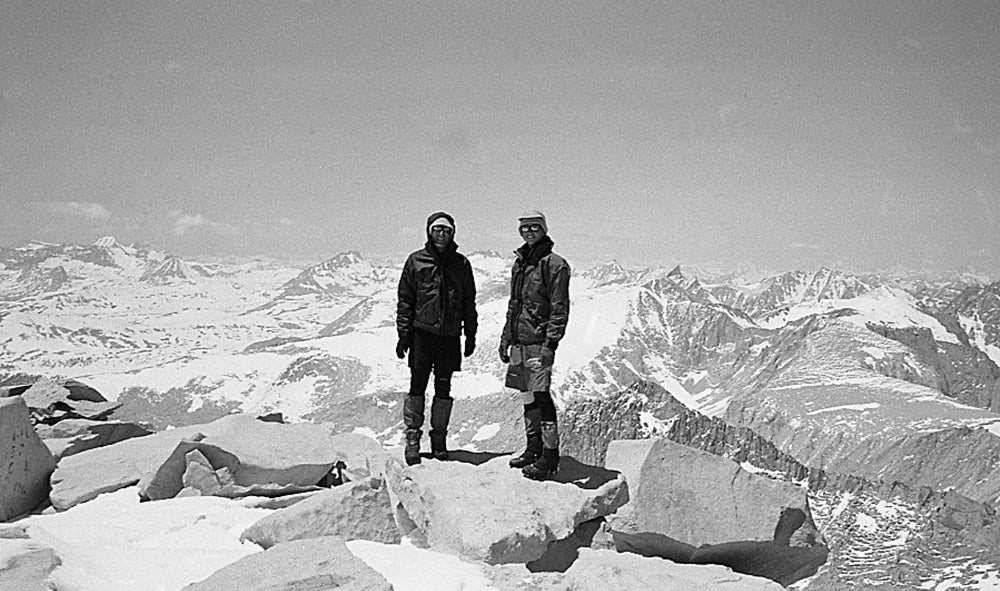

Sam: That brings us to 2019 and the second part of your trek. How had things changed on the trail?
Peter: Well, it’s a lot harder to do that kind of stuff when you’re 46. I’d had cortisone injections in my knees, and I’d spent the previous three years losing weight. But then at 46 you have money, so you can buy light gear and good food for yourself. It’s also less improvised because you have to plan other aspects of your life around it—your marriage, your career or the house that you own. Those aren’t the kind of things you’re concerned about when you’re 23—you just break up with your girlfriend, put your stuff in storage and turn your back on that. So that was quite different.
And there were way more people on the trail. Now, every year on the PCT they have a permit system and they cap it at 5,000. Someone told me that there were 300 Germans on the trail in 2019. So just from Germany there were more people than everybody in 1996. And then there’s this whole culture, where everyone has a trail name. There are two age groups—early 20s and then early to mid 60s—either people finishing university or trade school before starting a career, or people retiring. The young people start off solo, and then end up in what they call ‘tramilys’—these groups of five or six people who stick together. And now a big goal people have is to triple crown—hiking all three major trails in the US. They’ll blog, they might be hiking influencers or sponsored by gear companies, but all that stuff was non-existent in the 90s.
Sam: It’s a defined thing that people know about now.
Peter: It’s still a pretty obscure sub-culture but not anymore than something like BMX riding or people playing ultimate frisbee. Even if you don’t do it, you’ll maybe know someone who does. There’s a support structure too—there are apps which people might add comments on, there’s the Trail Association and there’s these Garmin things where you press a button and a helicopter will come and get you after you’ve broken your leg. There are trail angels which might show up at a random spot in the woods and cook hot-dogs for you. There are people who post their phone numbers by trail-heads to pick up hikers and take them to town. There’s this whole pilgrimage culture around it in these small towns—where they might expect 1000 people to come through in a month. It’s part of their economy, it’s part of their culture.
And also, I think in the 90s, we were seeing it as a rite of passage. It was a compliment to graduating university. That was the intellectual socially sanctioned pursuit, but this was a physical, emotional and spiritual component to that whole transition into adulthood, and we saw that as something that we had formulated in our own lives and invented for ourselves. Whereas now it’s much more common, and prescribed. “Take a gap year—travel across Australia, go backpack around Europe.” There are all these things that people’s parents and communities are happy to see them do, and I think that’s positive—I think people need to do that kind of stuff. But when we first did that, we had to convince people we weren’t insane.
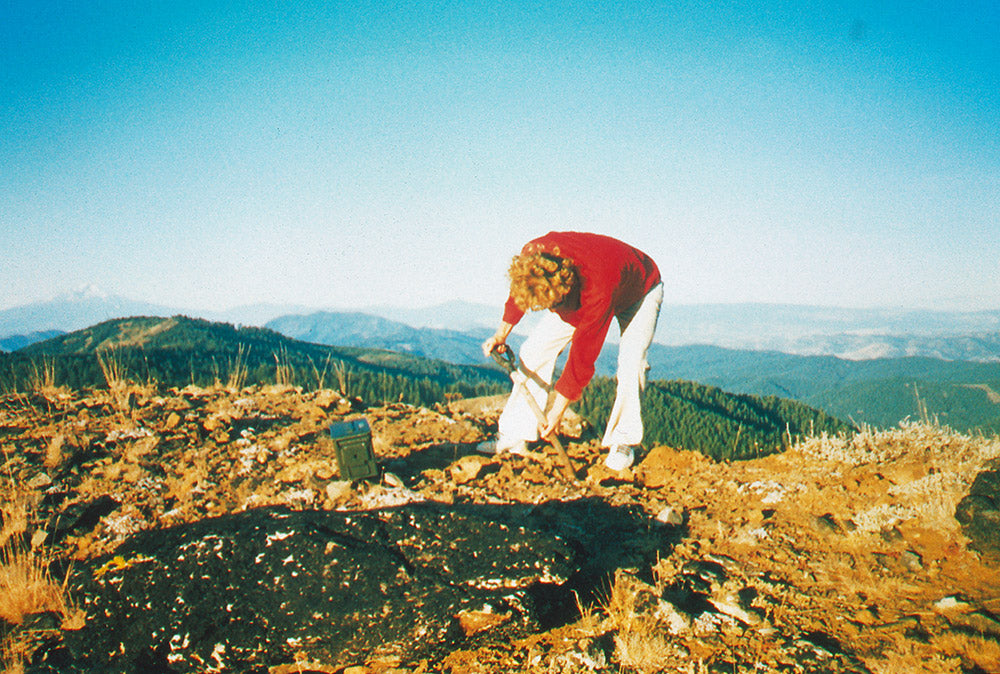

Sam: If you were 23 now, and you wanted to do some sort of self-prescribed rite of passage, being the kind of person you were, would you have to do something different?
Peter: Yeah I don’t know. I’m a university professor, and I had this student a while ago who was very different from myself in some respects, and very similar in a lot of others, and he had always wanted to do a walking trip like that. He was this iconoclast contrarian guy, and he walked from Washington DC to San Francisco, routeless. It wasn’t on a trail. He had a dog with him. I think that’s an example of how people take that drive to do something like that, but if they’re non-conformist, they try to figure out how to make it their own.
Sam: In the same way you were making it your own by the suit idea and the whole art thing. Just so I get all this straight as it’s quite a complicated story - what happened to the suit? Did you find it?
Peter: We got to Jackson Gap in Oregon, where we had buried the suit. I had pictures of me standing there with my shovel and the little box—and I had this very clear memory of hiking up this hill, and then burying it right by a rock, then putting a cairn of rocks on top of it. But when we got up there, everything was exactly how I remembered it, but there was no cairn of rocks.
Then Dylan—who’s an expert navigator—said, “Let me see that picture.” He held the phone up to the horizon and he said, “I don’t know where this picture was taken, but it wasn’t right here.” This big mountain, Mount Shasta, was on the other side. At that point I thought, “You know, maybe it’s kind of better that we leave that?” I saw the suit as this embodiment of my disaffected youth and my anti-social mentality, but maybe it wasn’t about that anymore? There’s this maturing that happens in the interim, where the things that are important to you, and the things that you signify to the world, become less important.
We spent an extra day looking for it, but you know—I did a lot of drugs back then—I was definitely high when I buried that suit. I do remember mirroring the picture at some point, because it fit some layout for something I was doing.
Sam: Maybe there’s someone walking around in your suit down in the town?
Peter: There’s this guy who we met on the trail who lives in Ashland, the town right near there. I sent a message to him putting it out as a bounty to the Ashland weirdo community—“Here’s the picture, the suit is somewhere around Jackson gap, there’s a bottle of top-shelf liquor for anyone who finds it.” I do occasionally think about going back—I think I could find it if I devoted a few days to it—but then sometimes I think you’ve got to leave things behind. It’s the past, you know?
Sam: That thing of letting go?
Peter: Yeah, you do these kinds of experiences to learn something about yourself and your place in the world. One of the most profound things you can learn is to accept when things aren’t going your way—to accept failure—to realise you can’t impose your will on the lived experience. You’ve got to roll with it.
Sam: Definitely. You mention that guy who tried for years to do that yo-yo thing up and down the PCT in one season. As amazing as it is, it’s also kind of arbitrary and—no disrespect to him—pointless. What do you think drives people to do these things? It’s not like he was being chased by the army or something, it was all free will.
Peter: I think there are two tiers of people. A lot of the retirees or the young people who are thru-hiking a trail—it’s something they’ve always dreamed about, and in an otherwise pre-prescribed existence, they have a chance to get out there for a while—getting back to some kind of primal living. It’s very functional in terms of transitioning you from one stage of life to the other, and aside from the practicality of those age groups—one finishing school, and the other finishing their careers—both of those groups are in this transition period—from youth to adulthood, or middle-age to old age. I think it’s a great way to psychologically reset yourself.
But then there’s people like Scott Williamson, or another example would be Anish Anderson, who’s a woman who has the fastest time on the PCT self-supported, and has done a single-year triple crown—where you do all three trails in one calendar year. Those people are explorers. Even though they’re on a well-trodden path, they’re doing it at a level that is akin to trekking across the North Pole or climbing Mount Everest. I think they’re very elite athletes, and that’s the thing they’ve settled on as being what they want to achieve.
I think that one thing that drives people to those kinds of activities is the psychological factor, and the individual nature. There are no rules, and you do it how you do it. It’s as much mental as it is physical. When you’re doing something like that, regardless of what level you’re at, for 75% of the time, it’s something that really sucks. The unofficial motto of thru-hiking is ‘embrace the suck’. At any time, you could just stop—worse case scenario you can hike another three days to get out to a road, and you can quit. So I think it’s the mental challenge of not quitting.
Sam: A lot of these kinds of things aren’t that fun at the time, but they’re funny to look back on. You almost laugh at how bad things were.
Peter: Yeah, they’re funny in retrospect. I’m about six feet tall, and in 1996 I weighed about 165 pounds. That’s pretty thin, and I lost 20 pounds in 30 days. After it was over we took a week off and just ate food, all day long every day. It’s funny to think about in retrospect, but I was literally starving.
And then on the most recent trip, it was raining 80% of the time, 24 hours a day. You wake up, your clothes are already wet from the day before, and it’s like that all day long. I remember thinking, over and over again, ‘I wish it would quit raining’. We were just talking about it all the time. And then it did quit raining… when it started snowing. And that’s what I look back on and laugh—what a dastardly trick nature played on us. It’s funny now, but at the time, it was pretty dire. You have to be extremely vigilant and very sobre-minded, everyday, to make sure you stay alive. One wrong move—like getting your sleeping bag wet—and all of a sudden it’s life-threatening.
Sam: Is the suffering part of it? Especially back in 1996, was it a case of ‘suffering for your art’?
Peter: Yeah, and I don’t think that necessarily goes away. In fact, there might be more of that as you get older, as the suffering is more. You don’t have the lack of understanding about the consequences, and your body isn’t as equipped to do it.
But yeah, that’s for sure part of it. It’s the ascetic experience—like wearing a hairshirt. And that’s a very universal human experience that we seek out. The wanderlust and the pain that’s associated with it. I’m very interested in experiencing that.
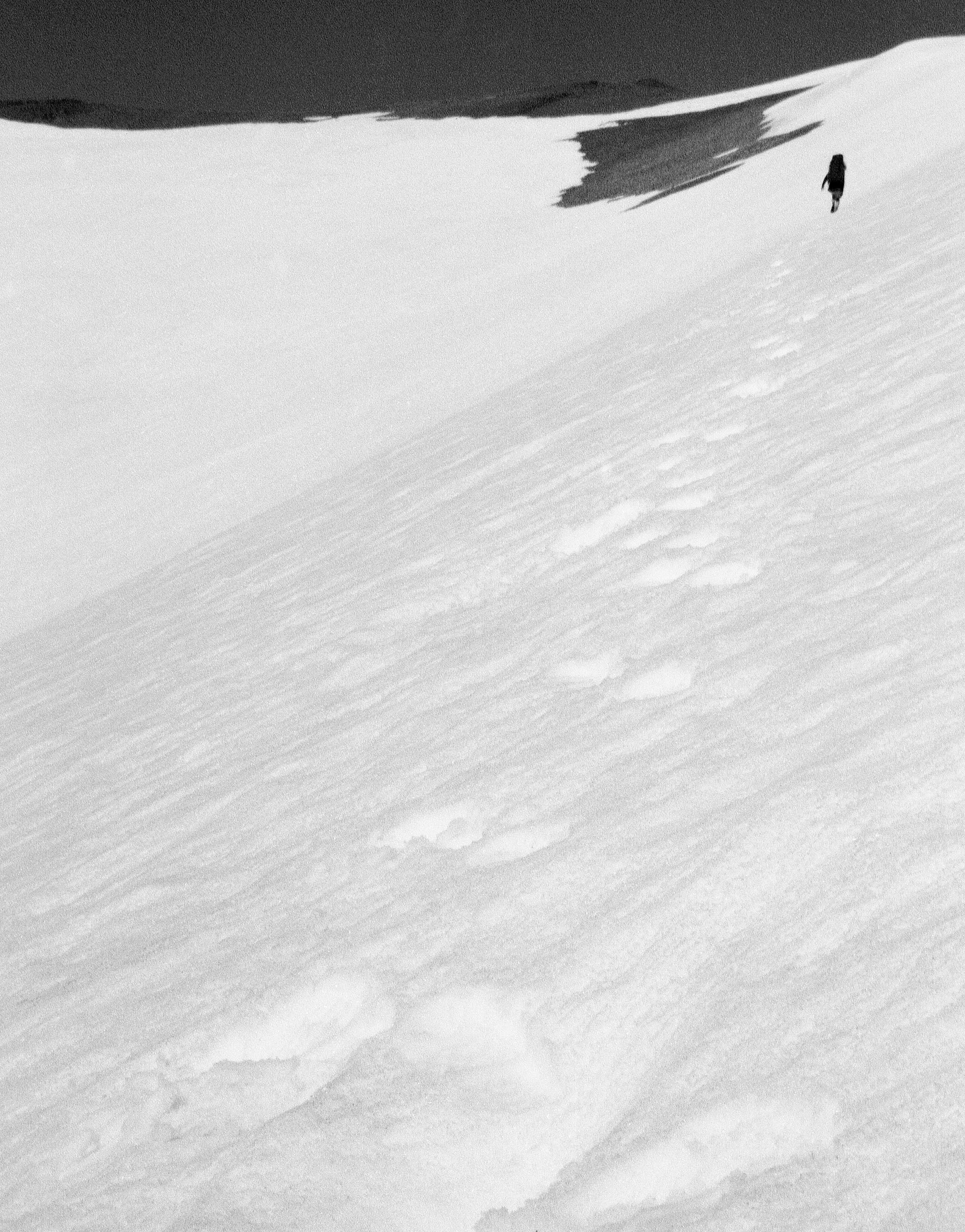

Sam: You’ve mentioned transformation a few times as we’ve talked—did finally completing the trek change you at all?
Peter: Yeah, I do feel that it kind of transitioned me into being okay with getting old. Being 46 you’re really in between, but out on the trail people definitely saw us as much older than they were. And then the retirement age people saw us as the junior members of their group. As soon as I was done with the first trip, I was thinking about how I could live more of a vagabond style life, but when I was finished with the second trip, I was thinking I needed to divert more money into my retirement account. I was thinking ‘what am I moving towards? What’s the rest of this going to look like?’ We joked about coming back in 23 years from now, and then we’d be 69 years old—and that’s old. Although someone did just complete the Appalachian Trail at 80…
Sam: You’ve got to go and find that suit first. Wrapping this up, have you got any wise words to add?
Peter: I think that everybody needs to get out and do something crazy, and push their limits, at least once in their life. And if they don’t do it purposefully, with some direction, it’ll maybe happen anyway when the timing isn't right. Get out and explore—go get lost. The body and soul need that.
I think it really just depends on your own lived experience—for myself and Dylan who were used to being out in the mountains, that meant a really long thru-hike—but maybe it’s as simple as taking a two-week road trip without a map? Just get outside of your comfort zone.
Find out more about Peter and Dylan’s PaCT project here and here.
